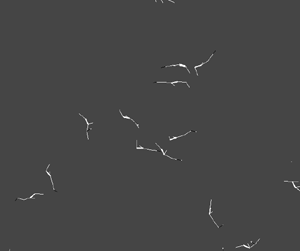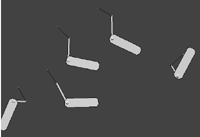
(Attractiveness vs. Efficiency)
8 Observations
For the sake of more controlled experiments and predictable results, the choice of what is attractive was taken out of the hands (or genes, as it were) of the swimbots. The 'favorite color' gene was removed, and the criteria for attractiveness were set up as the objectively-defined features (as described earlier). When attractiveness was set to equal Massiveness, the simulation produced thick-bodied swimbots which moved slowly, as expected. When it was set to equal Movement, large motions became the norm, and consequent swimming strategies became aggressive and bold. Openness resulted in bodies which were spread-out more, as illustrated in Figure 8, where each image represents 3 time steps. The population represented in this illustration exhibited a curious behavior: the stroke recovery (at the beginning and end of this sequence) appears more exaggerated than what would normally be expected.
It is as if the swimbots had overshot the motion, and opened-up inside-out. This behavior might have given some swimbots a slight advantage in being chosen. A pursuing swimbot sizing up mates can take a snapshot of a potential mate at any stage of its swim cycle to measure its attractiveness. Therefore, exhibiting open features through the majority of the swim cycle creates an advantage.
Attraction to Length resulted in unique behavior: bodies became extremely long, with few branches in their topology. The 'parent' genes (for part connectivity) had adapted to become more sequential. Figure 9 illustrates a group of swimbots from a population which evolved with this criteria. These swimbots exhibit very rigid postures, using a small paddle-like part at the end to propel forward. Over evolutionary time these paddling behaviors were replaced by graceful undulating motions in straight bodies.

Figure 9. A group of long swimbots
The Virtues of Vegetating
Setting attraction to be the inverse of these features revealed interesting results. For instance, in a simulation run in which attractiveness was set to equal lack of movement, the simulation produced a population of swimmers with sparse anatomy, and with very little motion. This simulation resulted in lower average energy efficiency than most other simulation runs (the time series graph which is not illustrated here reveals a relatively low, uneventful energy efficiency trend). A few qualitative observations were made from this simulation.
Since the simulation had produced swimbots who moved slowly, the fluid field exhibited a great patchwork quilt of phenotypes (indicated by coloration), since genotypes mixed at such a slow rate. Mating remained predominantly local. All swimbots however were very simple in anatomy, possessing only two parts, as shown in Figure 10.
Another observation was made: although swimming was slow, swimbot population rose dramatically. The explanation may be that since swimbots expended little energy, they were able to live long lives: a lower death rate. This large population then offered those few swimbots who were slightly mobile a wealth of potential mates within close proximity. Locomotion required for reproduction was not demanding of energy or time.

Figure 10. A family of slow swimbots from a population attracted to lack of movement
9 Conclusion
